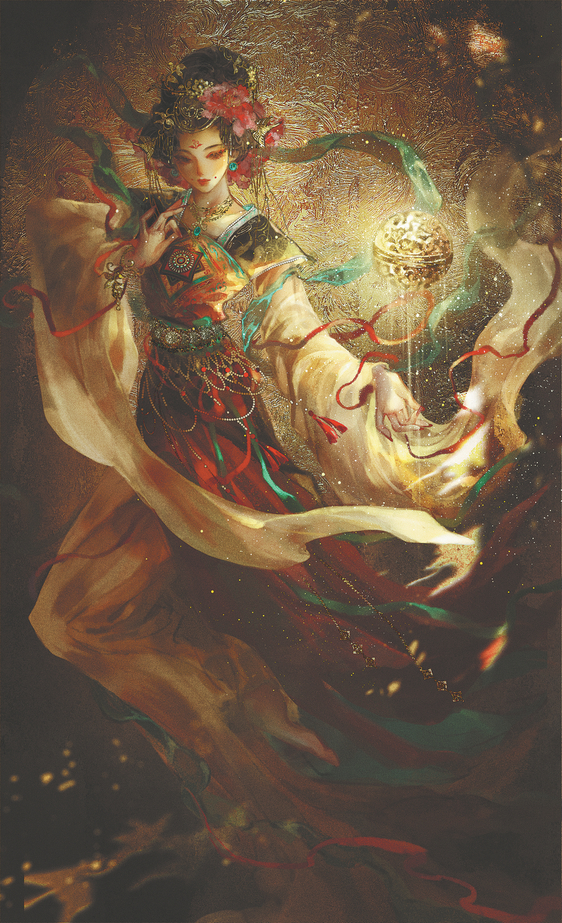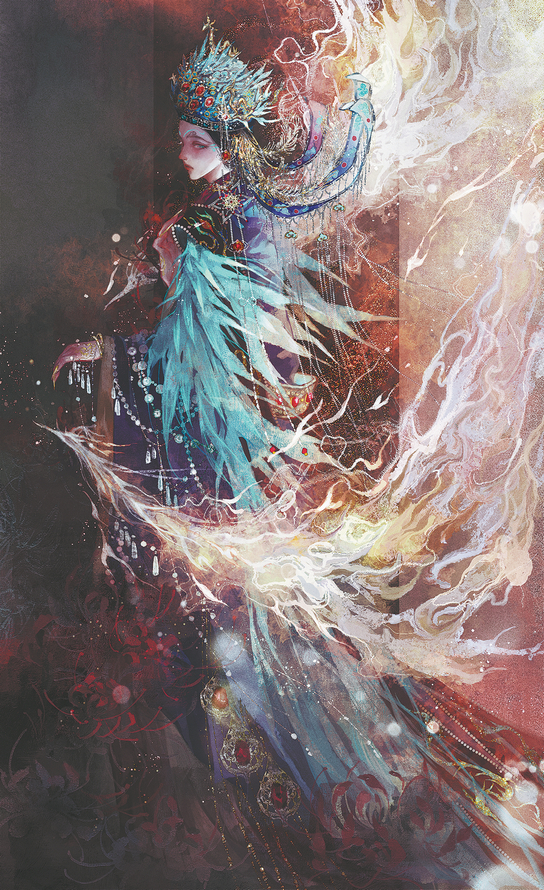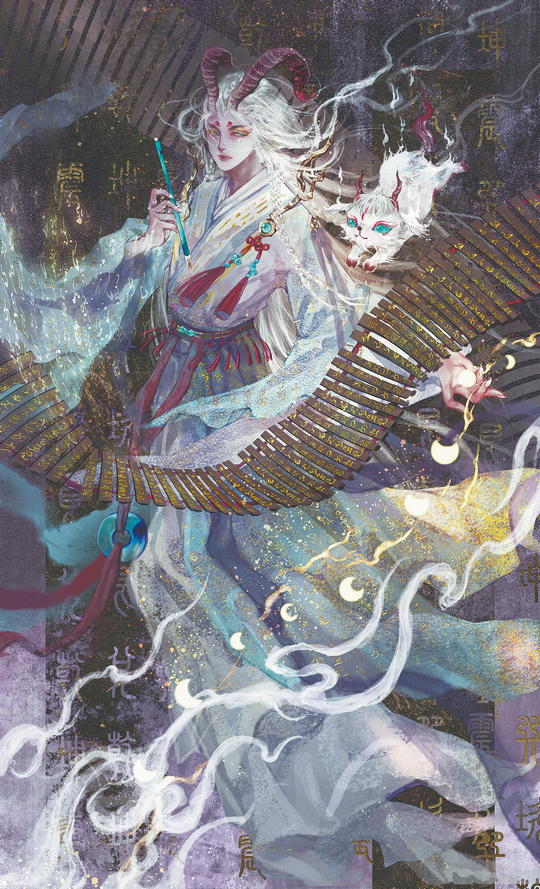A cultural phenomenon

Wan Yue's digital illustration centered on a silver incense burner that is kept at Shaanxi History Museum. [Photo provided to China Daily]
For the general masses, cultural artifacts may often seem antiquated and distant, yet a gifted few are able to exert their imagination and bring the objects vividly to life by capturing their essence through artistic expression.
Illustrator Wan Yue, as one of them, has found her own way of giving traditional cultural elements a modern touch with her ability to transform static objects into aesthetically pleasing characters.
From the different varieties of tea leaves, she sees a group of youths from ancient China, each with a unique appearance and personality. And from China's abundant resources of archaeological artifacts, she envisions ethereal, gallant or imperial characters, inviting viewers to explore their captivating stories, all grounded in Chinese history.
Known better as Yuyuqing on her social media accounts, she has been posting her digital illustrations, winning millions of followers and many requests for collaboration or to use her works in cultural merchandise, including China's well-received archaeological TV program National Treasure.
Wan says that, although she always loved animation and drawing from an early age, for years she kept her passion at bay and chose, instead, a stable job working in a bank.
In 2018, her son's kindergarten hosted a drawing competition. Helping her son with his entry rekindled her love for the art form, and she started taking courses in watercolor and portraiture.
She resigned from her job in 2020 with the goal of becoming a freelance illustrator, taking illustration courses and creating several series of paintings to accumulate experience and build her portfolio.
"Drawing a series of works on specific topics is a great way to practice my skills. These pictures use similar techniques, so I get to practice one technique intensively. Also, they feature different characters and allow me to exercise my imagination and creativity," Wan says.
So far, her subjects include tea, mythical creatures, ceramics and cultural artifacts, all representative elements of traditional Chinese culture.

Illustrator Wang Yue [Photo provided to China Daily]
"I have always been captivated by traditional culture, and this interest led me to start painting about it. It's a natural and serendipitous process of mutual attraction," she says.
One of her iconic illustrations is from her cultural artifact series, featuring a relic unearthed in 1970 — a silver incense burner with patterns of grapes, flowers and birds, now kept at Shaanxi History Museum in Xi'an, Shaanxi province.
The incense burner is ingeniously designed with a gyroscopic structure, comprising a three-axis gimbal (pivot) that is set so that it keeps the hemispherical incense holder at the center of the burner horizontal at all times. Even if the ornament is dangled from a belt, the incense inside would not spill out.
In Wan's rendition, a young woman dressed in hanfu (a style of traditional Chinese attire) is shown to be dancing, with the incense burner floating in midair above her hand.
"At the time, a few of my followers mentioned this artifact to me, so I started researching it. Not only does it look particularly intricate and exquisite, but it also moves me greatly with the history connected to it," she says.
The Old Book of Tang records that, after Yang Yuhuan, known as Yang Guifei, an imperial consort of Emperor Xuanzong of the Tang Dynasty (618-907), was sentenced to death, the emperor sent an official to check her tomb, who reported back that "the skin has decayed but the incense burner remains".
When the object was featured on National Treasure, archaeologist Qi Dongfang said that the incense burner artifact is of the same kind that belonged to Yang.
Intrigued by the incense burner's stability, Wan thought the best way to represent it would be through the motion of dance, and there was no more fitting option than to depict one of the most famous dances in Chinese history, Nishang Yuyi Qu (song of a rainbow and feather garment) — which, according to legend, was composed by Emperor Xuanzong and performed by Yang herself.

Wan Yue's digital illustration featuring a phoenix coronet from the Ming Dynasty (1368-1644) [Photo provided to China Daily]
"Because of these connections with Yang, I drew a Tang Dynasty noblewoman that resembles her. The character appears to be dancing, yet her posture and the position of the incense burner exude a sense of poise and balance," she says.
The ornaments worn by the dancing figure also incorporate the motifs found on the incense burner, including the patterns of grapes and birds.
She also sought inspiration from the murals in the Mogao Caves at Gansu province's Dunhuang, as Dunhuang culture was in its prime during the Tang Dynasty, merging clothing elements of the flying apsaras and the dark golden hue of the murals into her illustration.
"It's really a process of constant brainstorming, searching for and selecting elements with connections to the artifacts. For each painting, I start off with a draft based on a simple idea of the character, their posture and their clothing. I try out different possibilities, and then, step by step, present an aura that in my mind matches with the character."
From a more poetic way of thinking, she sees her creation process as an intuitive one, almost as if the artifact or object she's portraying possesses a "spirit of its own".
"When I am drawing, it seems that my subjects are tacitly guiding me to portray the impression they leave on me. It's not as if I am creating something new, but rather transferring their essence to paper," she adds.
Since her Chinese tea culture series helped her to make her mark online, she has gained more than 2 million followers on social media platforms such as Sina Weibo, Bilibili and Xiaohongshu, winning plaudits on the beauty of her artworks.
Xiaohongshu user Youbai says: "I'm absolutely stunned by her drawings that embody the breathtaking Chinese sense of beauty. Those cultural artifacts and mythological creatures, which I once felt detached from, come alive in her drawings. Each character of hers has their own unique story, and these stories make the drawings more vibrant."
Over the years, Wan observed that most of her followers are students at schools or universities, and that Chinese traditional culture is increasingly popular among young people.

Wan Yue's digital illustration themed on A Panorama of Rivers and Mountains by Wang Ximeng from the Song Dynasty (960-1279)[Photo provided to China Daily]
"Students are at the forefront of these new trends. As youngsters become more interested in traditional Chinese styles, the market is placing a greater emphasis on products that meet that demand. I think this is a symbol of growing confidence in our own culture," she says.
She is now working on a book that compiles her illustrations, as well as her own online courses, to share her knowledge and techniques with more people who may be interested in illustration and traditional Chinese aesthetics.
"I feel a sense of responsibility and honor to contribute, in my own meager way, to the promotion of traditional culture," she adds. "I have always been an ordinary person, and I'm humbled by the fact that my hobby can influence so many people."
Contact the writer at chengyuezhu@chinadaily.com.cn

Wan Yue's digital illustration featuring a mythological beast, Baize [Photo provided to China Daily]
Related articles
-
 JD Gaming win their first-ever MSI 2023 title after two back-to-back LPL championships
JD Gaming win their first-ever MSI 2023 title after two back-to-back LPL championshipsMore
-
 Prequel to the Mythical Diner: a Shop Hidden in the City
Prequel to the Mythical Diner: a Shop Hidden in the CityMore
-
 Where Winds Meet - Official Extended Gameplay Reveal Trailer | gamescom 2022
Where Winds Meet - Official Extended Gameplay Reveal Trailer | gamescom 2022More
-
 TheShy gets a ticket to Worlds Finals as a birthday present
TheShy gets a ticket to Worlds Finals as a birthday presentMore
-
 A cultural phenomenon
A cultural phenomenonMore
-
 Slam Dunk movie triggers nostalgic wave
Slam Dunk movie triggers nostalgic waveMore
